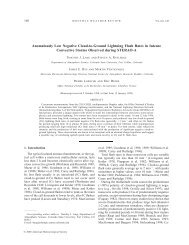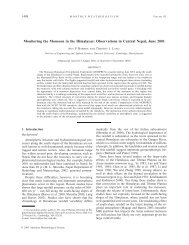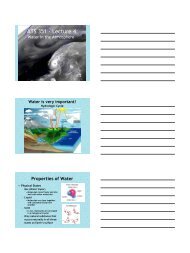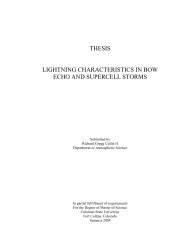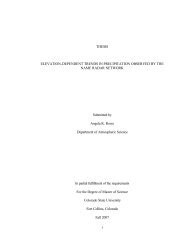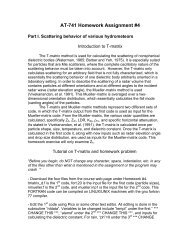1 A dual-polarization radar hydrometeor classification algorithm for ...
1 A dual-polarization radar hydrometeor classification algorithm for ...
1 A dual-polarization radar hydrometeor classification algorithm for ...
Create successful ePaper yourself
Turn your PDF publications into a flip-book with our unique Google optimized e-Paper software.
398399400401402403404405406407408409410411412413414415416417418419domain but the ML is “painted” into the <strong>classification</strong> <strong>for</strong> reference, as in Fig. 5b and 5c. Ifcomplete melting occurs, the above and below ML HCAs are stitched together above and belowthe ML median height and the melting layer is also included. The latter iteration is chosen <strong>for</strong>Fig. 5d. When K dp is noisy above and within the melting layer, it is useful to restrict plates anddendrites above 0.5-0.7 km of the ML top and keep wet snow pixels below this level. Thistechnique was used in Fig. 5.b) Membership beta functionsThe categories in each HCA step are assigned a score depending on the <strong>radar</strong> variables’ fitinto that category’s MBF, which is defined by its center value (m), half width (a), and slope (b).Each <strong>radar</strong> variable in an MBF is assigned a weight (0-100%) in calculating the score. The<strong>hydrometeor</strong> category with the highest score is determined to be the dominant bulk <strong>hydrometeor</strong>type in a particular <strong>radar</strong> gate. The expected value ranges in Fig. 1 and Table 2 were modified,usually by trial and error, to produce the MBFs in Figures 6-8 and Table 5 as follows:1. Implement slope (b) parameters to gra<strong>dual</strong>ly widen the MBFs but preserve the preciseboundaries between categories predicted by scattering simulations.2. Increase maximum aggregate K dp values incrementally <strong>for</strong> decreasing & and slightly extendthe minimum K dp allowed <strong>for</strong> dendrites to reduce dendrite over-<strong>classification</strong>.3. Increase maximum Z dr <strong>for</strong> aggregates to 1 dB (regarded as acceptable <strong>for</strong> <strong>classification</strong>purposes considering noise, uncertainty, and the varying degree of aggregation by Bader etal. 1987, Illingsworth et al. 1987, and Straka et al. 2000).4. Decrease minimum Z h <strong>for</strong> dendrites and aggregates to -1 dBZ to account <strong>for</strong> not modelingspherical or extremely small particles <strong>for</strong> either category.19



